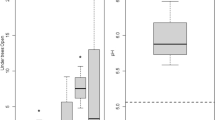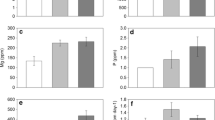Abstract
Patches of common juniper (Juniperus communis L.) shrubs potentially facilitate the formation of fertile islands in heath tundra ecosystems thereby influencing the long-term resilience of these ecosystems. Although the role of juniper in the formation of such ‘islands of fertility’ has been studied in semiarid landscapes, there has been little attention paid to the importance of juniper in other ecosystems. In this study we contrast the soil fertility and rates of N fixation under juniper shrubs with that in open heath tundra in northern Sweden. Plots were established at several individual sites in alpine heath tundra in Northern Sweden and mineral soils to a depth of 10 cm were characterized for available N and P and total C, N, P, Ca, Mg, K, Fe, Mn, Zn, and Cu. Nitrogen fixation rates were measured by acetylene reduction in feather mosses under juniper canopies and contrasted with N fixation in both feather mosses and surface soils in the open heath. Soils under juniper had concentrations of total P greatly in excess of P in open heath, furthermore, juniper islands had the highest concentrations of bioavailable P. Nitrogen fixation rates in the feather moss Pleurozium schreberi (Bird.) Mitt were approximately 150 μmol acetylene reduced m−2 d−1 under the juniper canopy compared to less than 10 μmol acetylene reduced m−2 d−1 in the open heath. Feather mosses under the juniper canopy also fixed N at a significantly higher rate (on an aerial basis) than that of surface cores from the open heath that included lichen, mosses, and soil crusts. Juniper facilitates the formation of islands of soil fertility that may in turn facilitate the growth of other plants and positively influence the long term recovery of heath tundra ecosystems following disturbance.




Similar content being viewed by others

References
Aas B, Faarlund T (2001) The Holocene history of the Nordic Mountain Birch Belt. In: Wielgolaski FE (ed) Nordic Mountain Birch Ecosystems, pp 5–22
Adams RP, Pandey RN, Leverenz JW, Dignard N, Hoegh K, Thorfinnsson T (2003) Pan-Arctic variation in Juniperus communis: historical biogeography based on DNA fingerprinting. Biochem Syst Ecol 31:181–192
Barlow V (2006) Species in the spotlight: common juniper, Juniperus communis. Northern Woodlands Magazine 50:33–34
Bates JD, Svecar TJ, Miller RF (2002) Effects of juniper cutting on nitrogen mineralization. J Arid Environ 51:221–234
Chin S, Wang GG (2002) Spatial and temporal pattern of White Spruce regeneration within mixed grass prairie in the Spruce Woods Provincial Park of Manitoba. J Biogeogr 29:903–912
Cleveland CC, Townsend AR, Schimel DS, Fisher H, Howarth RH, Hedin LO, Perakis SS, Latty EF, Von Fischer JC, Elseroad A, Wasson MF (1999) Global patterns of terrestrial biological nitrogen (N2) fixation. Global Biogeochem Cycles 13:623–645
Clifton SJ, Ward LK, Ranner DS (1997) The status of Juniperus communis L. in northeast England. Biol Conserv 79:67–77
DeLuca TH, Zackrisson O, Gentili F, Sellstedt A, Nilsson MC (2007) Ecosystem controls on nitrogen fixation in boreal feather moss communities. Oecologia doi:10.1007/s00442-006-0626-6 On line first
DeLuca TH, Zackrisson O, Nilsson M-C, Sellstedt A (2002a) Quantifying nitrogen-fixation in feather moss carpets of boreal forests. Nature 419:917–920
DeLuca TH, Nilsson M-C, Zackrisson O (2002b) Nitrogen mineralization and phenol accumulation along a fire chronosequence in northern Sweden. Oecologia 133:206–214
Farjon A (1998) World checklist and bibliography of conifers. Royal Botanical Gardens, Kew, UK, 298 pp
Garner W, Steinberg Y (1989) A proposed mechanism for the formation of ‘Fertile Islands’ in the desert ecosystem. J Arid Environ 16:257–262
Gentili F, Nilsson MC, Zackrisson O, DeLuca TH, Sellstedt A (2005) Physiological and molecular diversity of feather moss associative N2 fixing cyanobacteria. J Exp Bot 56:3121–3127
Grubb PJ, Lee WG, Kollman J, Wilson JB (1996) Interaction of irradiance and soil nutrient supply on growth of seedlings of ten European tall-shrub species and Fagus sylvatica. J Ecol 84:827–840
Haapasaari M (1988) The oligothrophic heath vegetation of northern Fennoscandia. Ann Bot Soc Vanamo 34:1–127
Harper KT, Belnap J (2001) The influence of biological soil crusts on mineral uptake by associated vascular plants. J Arid Environ 47:347–357
Hellberg E (2004) Historical variability of deciduous trees and deciduous forests in Northern Sweden—effects of forest fires, land-use and climate. In: Forest Vegetation Ecology. Swedish university of agricultural sciences, acta universitatis agriculturae sueciae, Silvestria 308., Umeå
Hörnberg G, Östlund L, Zackrisson O, Bergman I (1999) The genesis of two Picea-Cladina forests in northern Sweden. J Ecol 87:800–814
Houle D, Guthier SB, Paquet S, Planas D, Warren A (2006) Identification of two general of N2-fixing cyanobacteria growing on three feather moss species in boreal forests of Quebec, Canada. Can J Bot 84:1025–1029
Houle G, Babeux P (1994) Variations in rooting ability of cuttings and in seed characteristics of five populations of Juniperus communis var depressa from subarctic Quebec. Can J Bot 72:493–498
Hulten E, Fries M (1986) Atlas of North European vascular plants: north of the Tropic of cancer. Koeltz., Köningstein
Hustich I (1953) The boreal limits of conifers. Arctic 6:149–162
Klemmedson JO, Tiedemann AR (2000) Influence of western juniper development on distribution of soil and organic layer nutrients. Northwest Sci 74:1–11
Kuo S (1996) Phosphorus. In: Sparks DL (Ed) Methods of soil analysis: Part 2—Chemical and biological methods. Soil Science Society America, Madison, WI, USA, pp 896–919
Liedgren L, Bergman I, Hörnberg G, Zackrisson O, Hellberg E, Östlund L, DeLuca TH (2007) Radiocarbon dating of prehistoric hearths in alpine northern Sweden: problems and possibilities. J Archaeol Sci, (in press)
Lindsay WL 1979 Chemical equilibrium in soils. John Wiley & Sons, New York
Lynch JP, Brown KM (2001) Topsoil foraging—an architectural adaptation of plants to low phosphorus availability. Plant Soil 237:225–237
McCarron JK, Knapp AK, Blair JM (2003) Soil C and N responses to woody plant expansion in a mesic grassland. Plant Soil 257:183–192
McGovern TH, Bigelow G, Amorosi T (1988) Northern Islands, human error and environmental degradation—a view of social and ecological change in the medieval north Atlantic. Human Ecol 16:225–270
Miller CR, Ochoa I, Nielsen KL, Beck D, Lynch JP (2003) Genetic variation for adventitious rooting in response to low phosphorus availability: potential utility for phosphorus acquisition from stratified soils. Funct Plant Biol 30:973–985
Morris DM, Gordon AG, Gordon AM (2003) Patterns of canopy interception and throughfall along a topgraphic sequence for black spruce dominated forest ecosytems in northwestern Ontario. Can J For Res 33:1046–1060
Mulvaney RS (1996) Nitrogen—inorganic forms. In: Sparks DL (Ed) Methods of soil analysis: Part 2—Chemical and biological methods. Soil Science Society of America, Madison, WI, USA, pp 1123–1184
Påhlsson L (1994) Vegetationstyper i Norden, Köpenhamn
Pearson HJ, Vitousek PM (2002) Soil phosphorus fractions and symbiotic nitrogen fixation across a substrate age gradient in Hawaii. Ecosystems 5:587–596
Rosen E, Bakker JP (2005) Effects of agri-environment schemes on shrub clearance, livestock grazing and plant diversity in low intensity farming systemson Öland, Sweden. Basic Appl Ecol 6:195–204
Rousset O, Lepart J (2000) Positive and negative interactions at different life stages of a colonizing species (Quercus humilis). J Ecol 88:401–412
Schlesinger WH, Raikes JA, Hartley AE, Cross AF (1996) On the spatial pattern of soil nutrients in desert ecosystems. Ecology 77:364–374
Schöllhorn R, Burris RH (1967) Acetylene as a competitive inhibitor of nitrogen fixation. Proceedings of the National Academy of Science USA 58, 213–218
Solheim B, Wiggen H, Roberg S, Spaink HP (2004) Associations between arctic cyanobacteria and mosses. Symbiosis 37:169–187
Stevenson FJ, Cole MA (1999) Cycles of the soil. John Wiley and Sons, Inc., New York, NY
Thompson TL, Zaady E, Huancheng P, Wilson TB, Martens DA (2006) Soil C and N pools in patchy shrublands of the Negev and Chihuahuan deserts. Soil Biol Biochem 38:1943–1955
Thomson AM, Simpson IA, Brown JL (2005) Sustainable rangeland grazing in Norse Faroe. Human Ecol 33:737–761
Tiedemann AR, Klemmedson JO (1995) The influence of western juniper development on soil nutrient availability. Northwest Sci 69:1–8
Van Miergroet H, Hysell MT, Johnson AD (2000) Soil microclimate and chemistry of spruce-fir tree islands in northern Utah. Soil Sci Soc Am J 64:1515–1525
Walter H, Breckle SW (1989) Ecological systems of the Geobiosphere. Springer, Berlin
Wang B, Qiu Y-L (2006) Phylogenetic distribution and evolution of mycorrhizas in land plants. Mycorrhiza 16:299–363
Zaady E, Groffman PM, Shachak M (1996) Litter as a regulator of N and C dynamics in macrophytic patches in Negev desert soils. Soil Biol Biochem 28:39–46
Zackrisson O, DeLuca TH, Nilsson M-C, Sellstedt A, Berglund LM (2004) Nitrogen fixation increases with successional age in boreal forests. Ecology 85:3327–3334
Acknowledgements
The authors wish to thank Tricia Burgoyne, Rachel Brimmer, Clarice Pina, and Michael Gundale for laboratory assistance and two anonymous reviewers for their comments on this manuscript. This work was funded in part by grants from Formas and the Bank of Sweden Tercentenary Foundation.
Author information
Authors and Affiliations
Corresponding author
Rights and permissions
About this article
Cite this article
DeLuca, T.H., Zackrisson, O. Enhanced soil fertility under Juniperus communis in arctic ecosystems. Plant Soil 294, 147–155 (2007). https://doi.org/10.1007/s11104-007-9242-4
Received:
Accepted:
Published:
Issue Date:
DOI: https://doi.org/10.1007/s11104-007-9242-4



